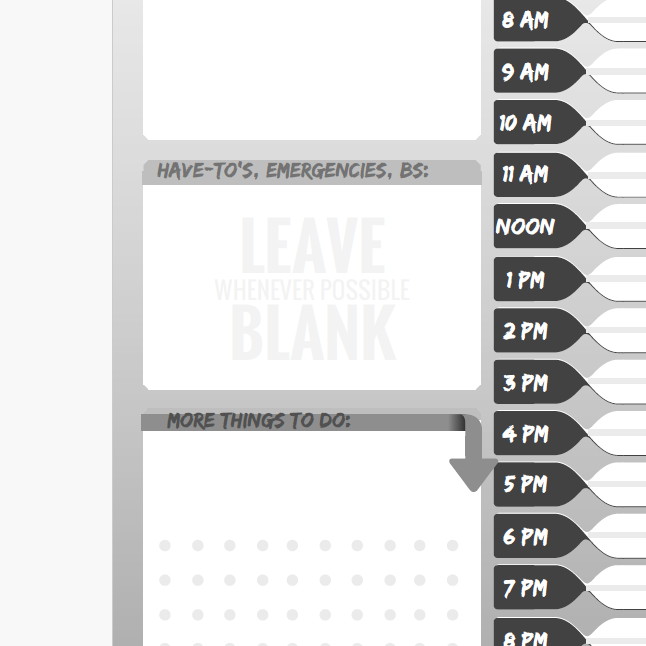After adding my free printable 24-Hour Daily Planner to my Ko‑fi shop, I’m thinking about my other planners and trackers, and how to design more of them, better.
One thing that occurred to me as I wrote the description for the 24-Hour Daily Planner is this: a great plan doesn’t have to be CRAMMED with text, to-do’s and notes, nor does a great log, journal, efficiency sheet or timesheet for a day necessarily contain a full page of a whole bunch of things done.
I’m really glad opening this Ko‑fi shop forces me to look at my planners and trackers with fresh eyes.
When I created the 24-Hour Daily Planner, I designed a whole box for “HAVE TO’S, EMERGENCIES, & BS”: a blank container for the things you might not want to do, but absolutely HAVE to do.
Within that emergency “HAVE-TO’S” box, though, I planted a soft whisper of advice printed in light grey: “LEAVE BLANK WHENEVER POSSIBLE”:

The idea is this: leave room for emergent things you must attend to. Contain the bullshit and the chores and the obligations that don’t fuel you up but rather drain you within a small, appropriately-sized portion of your vision and plans for the day.
Most importantly: question how important or necessary these chores and bullsh*t actually are. Are they really “emergencies”? If not, recognize you do not actually have to do them. They are optional, and/or far less threatening than you feel.
If nobody is going to die, be hospitalized, or go to bed hungry tonight if you don’t do a thing, then
How important is it?
At the end of the day, seeing a blank white box here is an opportunity to be grateful: there were no actual emergencies in my life today. I did chores I may not have enjoyed because I am a caring, capable, conscientious, and responsible person (NOT because I was forced to). I do many unpleasant tasks because they add up to making life better; I choose to do these things even though the world will not end if I don’t get to them today.
*****
I’d love to talk more about the rationale and research behind my leave-the-emergencies-box-blank approach, and chronic stress and how many of us are programmed to opt into it at the expense of our health, and the science around all of that, but that’s a bit off-track for now.
For me, today, the actionable part of this reflection on have-to’s, emergencies, and most-importantly (today) white space is this: more is not necessarily better. Longer lists don’t necessarily lead to more success. Making room for EVERYTHING on a single sheet of paper may not leave enough space for clarity, fulfillment, or a sense of mastery.
White space is one of the most (if not THE most) important elements of design. Just like rests (silences) in music are what give audible notes emphasis and rhythm, white space around words or images directs our eyes to what is important.
The blank spaces in music build tension and signify RELEASE: the stop to the go. Constant unending sound does not make for good rhythm or great music. If we are not planning our stops and rests in addition to our going and doing, it is hard to be motivated; we need to have an end in sight.
The more white space you have in your planner, the more clearly you can see what is important. The more obvious it is when you have arrived.
Anyhoo … I’d like to make more planners with more white space.
I look forward to seeing how much more (or less?) we get done (and how many more meaningful life-shaping rests we take) with some days and tasks clearly cushioned by space intentionally left blank.
